99 Ways to Engage Students in Unprecedented Times
Virginia Mawer is a language teacher, curriculum designer, writer, examiner and speaker. Currently based in Sydney, she has worked in the private sector and university programs in Australia and internationally. Her interests include finding creative ways to adapt to new challenges, increasing student engagement through meaningful interactions, and employing technology in learning. Email: virginia.mawer@gmail.com
Introduction
Remember the days when trying to get students to get off their devices and engage with the room was our biggest problem? Ah, happy days.
In these “unprecedented times”, although I have come to detest the phrase, education has become infinitely more difficult. Colleagues in the sector tell me they’re working harder to get some form of connection with their students, and often feel like they’re failing to reach their learners.
Pre-covid, the pervasive use of mobile phones in TESOL classrooms was a contentious issue because of propensity for devices and/or technology to distract and therefore disengage students from their learning. The issue is no longer how to avoid the distractions on devices, but how to engage the students through their devices. Brave New World.
The issues now seem to involve potentially competing against other online content, multiple devices in the student’s vicinity, tech issues, concentration issues, pandemic anxiety, the list goes on. And although I am not a monster, I will admit I’m guilty of focussing on how hard it is for me and so often find it hard to empathise with my students’ needs. Quite often what my students really need is authentic relationships and engaging content, and here is a learning tool that can meet both of those needs: emoji.
That’s right, welcome to the wonderful world of emoji! I have included a variety of online learning tasks that can be adapted for purpose. For more ideas, have a look at http://www.99waysesl.com/ which is a blog of helpful ideas for TESOL and academic English teachers.
Emoji Warmers
1 Emoji Feelings
Type an emoji to describe
- how you’re feeling now (vs last night/last year)

-

how you will feel after class/after the exam? -
your best holiday in emoji -
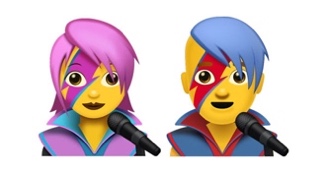
your future career (Rockstar!)
2 Emoji Opposites
This can be played with emoji or words, it can be fun either way.
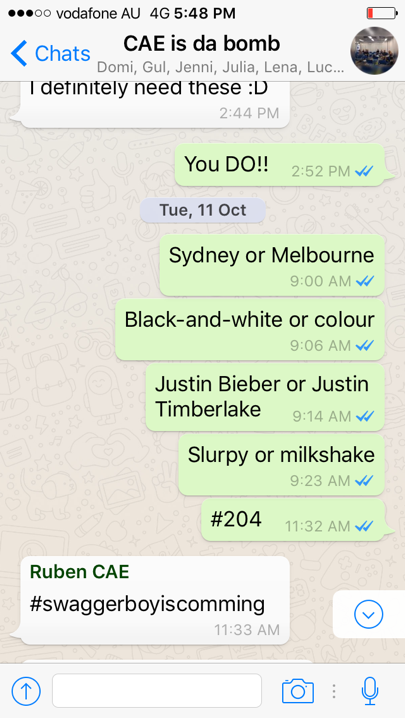 |
Teacher types opposites and students must debate which is better. There are a million variations but this activity can be used to practice comparative language, language of opinion, persuasion, active listening and many more!
Emoji Vocab
1 Emoji Vocab Quiz
Teacher types or displays an emoji on the ppt or whiteboard, students have to type the spelling in the chat box. First correct answer wins! This could also be a listening to writing task if you don’t want to use emoji…but who wouldn’t?!
Amp it up – for lower level students, include singular, plural or quantifier tasks by typing the same emoji e.g. 5 x pig emoji = "several pigs"




Share the power-the winner of each round gets to provide the next emoji and decide the winner (Teacher can adjudicate if necessary!)
Options – everyone has to type it correctly, even if they didn’t win.
2 Emoji Dictionary
Students can learn new vocabulary by hovering their mouse over an emoji and often it tells them what the emoji means. They can then share this with their classmates.
3 Emoji Bingo
Create a set of bingo cards with emoji themes of e.g. vegetables, clothing, animals, jobs etc. Teacher reads out the names of the items (or types them) and students have to cross off their emoji until they have bingo.
Alternatively (or additionally), provide bingo cards with words on them and then display/type one emoji at a time. Students have to cross off their word bingo cards until they have bingo.
Make it harder by adding one or more incorrect spellings of the same item e.g. vegetable.
4 Emoji Gap Fill
Make a standard gap fill more interesting. Teacher creates a gap fill with emoji as the gaps i.e. the students have to replace the emoji with the correct word.

Share the power – students make their own emoji gap fill task and their breakout room partner has to respond with the missing word/s.
5 Emoji Vocab Research
Assign a different word for each pair to look up. They need to write the word and definition in their own words and present back to the class
6 Emoji Memory Check
As a way to recycle vocab, randomly type one of the emoji vocab words learnt yesterday/last week and get students to type in the correct word. Then they can respond with other emoji they remember learning (and of course the English meaning) e.g. phrasal verbs from last week could be revised like this


crack down


act out

lag behind

resign oneself to
7 Emoji Connection
Put 2 random emoji together and get students to determine the connection. This can be done as a plenary to begin with, then students can try creating their own combinations and asking others if they see the connection.
8 Emoji Reverse Pictionary
Teacher provides an emoji to students A, who have to type (not speak) the word in a private chat to students B. Student B then has to type the correct emoji to the class chat. In order to maintain decorum, I always make private chats visible to the moderator, if your platform allows. Alternatively, the winning pair has to send their chat to the group a) for fun and b) to prove that there was no emoji cheating going on!!
9 Emoji Scategories
Teacher provides 5 categories (e.g. one country/city/sport/adjective/verb) and then sends one letter of the alphabet. Teams must reply with 1 message only, including one emoji that represents all 5 words.
Once a winner is announced, the rest of the class must guess what each emoji represents and the winning team adjudicates. Winners of that round and get to select the next letter.
Emoji Storytelling
1 Emoji Movie Plots
Here are 3 famous movies in emoji storytelling format. Can you name these movies?
a
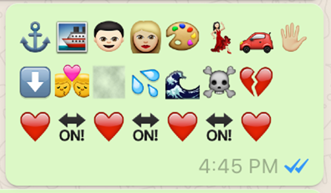
b
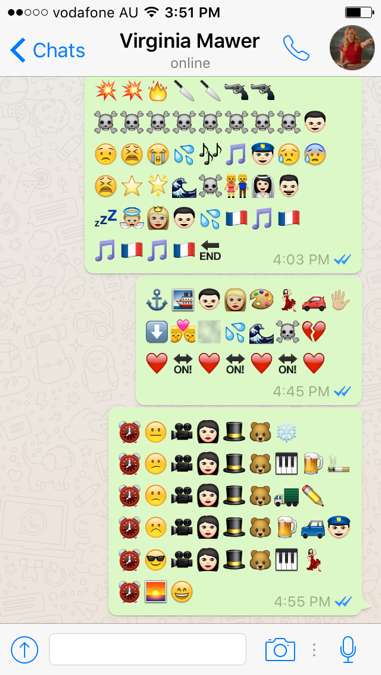
c
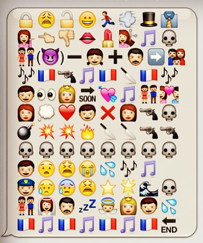
Guess what they are, and check your answers (and have a look at some other very funny emoji stories) at https://narrativesinemoji.tumblr.com/
Teacher sends a famous story in emoji. Students have to work together to guess the title or work out if they know it, and then re-tell the story, or add to it as they see fit. Students can then create their own emoji versions of famous movies and send them to the groups.
2 Emoji Retelling
Send the students a written story, or read one out, and after proceeding with the usual comprehension, specific information and inference questions, students then retell the story to their group using emoji.
The next stage is for students to write their own emoji story and send it to another group, who write the story out in words and send it back to the group.
Another take on this would be to release the story one emoji at a time (or in chunks) and students either guess what's happening, what's coming next, keep adding to the story by incorporating each new element as it appears or just re-tell the story with each modification.
Students can create their own emoji stories and upload them on sites like this- http://emojitales.com/
3 Emoji Story Building
Create a story one word at a time. Students organise themselves in groups or with assigned numbers. Student 1 types an appropriate word to begin a sentence, then student 2 adds a word and/or punctuation. To add a livelier element, get students to say the word when it appears on their screens. Then, add a memory and pronunciation element by putting pairs in breakout rooms to tell each other the story.
4 Emoji Random Story
Ask each student to contribute 1 emoji to the group chat (at the same time), and small groups have to go and create a story based on the emoji suggestions, and then come back and share their stories with the class.
Emoji for Academic Purposes
1 Emoji Academic Linkers
Getting students to learn and practice a variety of discourse markers can potentially be dry and repetitive, but using emoji symbols can illustrate a number of ideas, including cause and effect.
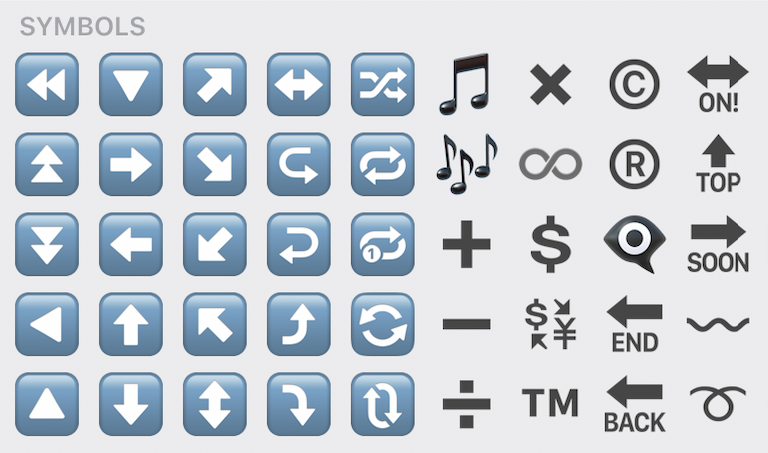
2 Emoji Essay Plans (especially the symbols)

This can get process really clear.
3 Emoji Formal vocabulary
Provide an emoji and students need to replace the emoji with academic vocabulary.
Parting word
As I hope you’ll agree, emoji can communicate fun, warmth and joy, they can help learn and practice vocabulary, improve creative and associative connections, help make storytelling (and lessons) engaging. the world has gone mad. We don’t have to.
Despite the challenges, the great thing about being online is our “unprecedented” access to emoji. Most online learning platforms that I’ve worked with seem to have the emoji feature, and if they don’t there’s always the chance to text it to yourself and copy it across.
The mammoth shift in the way we deliver lessons and engage with students has been nothing short of miraculous. Kudos to all who have embraced the changes, willingly or not, and who have drawn deep into their resilience supply to carry on, and to bring...carry the students along with us.
Please check the Creating a Motivating Environment course at Pilgrims website.
Please check the 21st Century Skills for Language Teachers course at Pilgrims website.
Please check the Practical Methodology and Language for Primary Teachers course at Pilgrims website.
Please check the Practical Methodology and English Language Development for Secondary Teachers course at Pilgrims website.
Please check the Practical Ideas for Teaching Advanced (C1-C2) Students course at Pilgrims website.
99 Ways to Engage Students in Unprecedented Times
Virginia Mawer, AustraliaEncouraging Critical Thinking Through a Dialogic Teaching Approach in the Beginner-level English Classroom
Skye Playsted, Australia